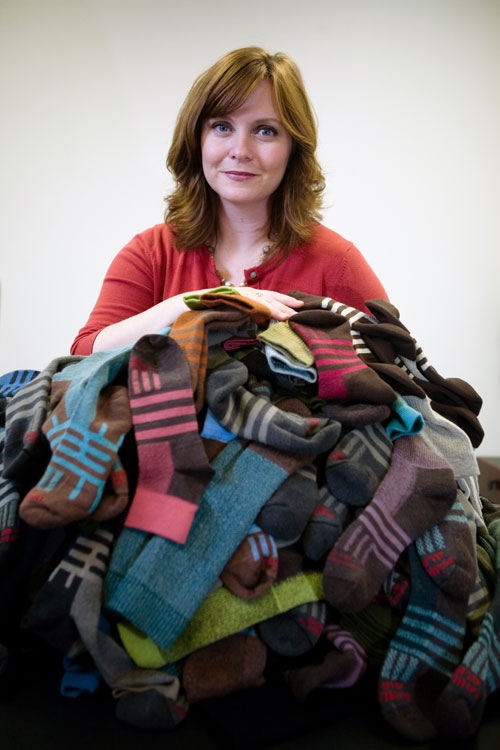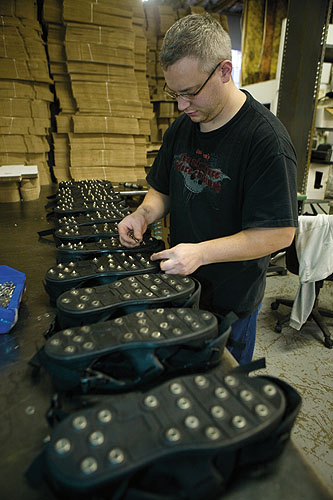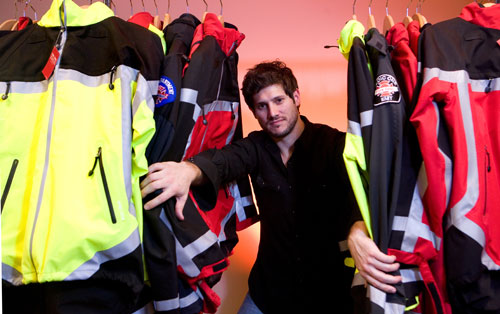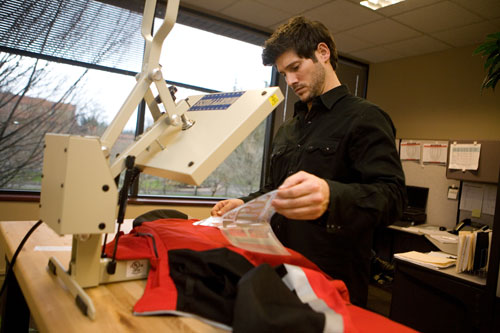 Portland’s apparel cluster thrives on creative minds, active lives and nearby giants.
Portland’s apparel cluster thrives on creative minds, active lives and nearby giants.
Portland’s apparel cluster thrives on creative minds, active lives and nearby giants.
STORY BY JON BELL // PHOTOS BY KATHARINE KIMBALL
 |
A creative workforce, quality of life and a solid apparel reputation lured Kris Dahlgren and her family’s hiking-sock company to the Portland area in 2006. |
In 2006, after more than 25 years in east Los Angeles County, hiking-sock maker Dahlgren Footwear decided that it was time to hit the trail and find a new home.
Kris Dahlgren, vice president of the company her father founded in 1979, says the local hiring pool, which was largely non-hiking, wasn’t cutting it and the corporate culture, where a big dog sets the standard and everyone else follows, had grown old for a company used to doing its own thing.
Dahlgren also wanted to be closer to the core of the outdoor apparel industry — hint: it’s not in East L.A. — in a place where designers and other creative consultants were close at hand. There had to be a major airport nearby and, perhaps most importantly, the new locale had to feel like a permanent vacation spot.
Tualatin, Oregon, here we come.
“After three years, it just feels like I was always an Oregonian but born in the wrong place,” says Dahlgren. “And it’s really made sense for a whole host of factors related to the business.”
Everything that drew Dahlgren to the Portland area — the creative-class workers, the quality of life and the growing reputation that Portland is the place to be for outdoor apparel, footwear and even a bit of fashion — is also what has appealed to an expanding number of small specialty clothing and shoe startups moving into Nike’s territory. The list is long and includes everything from snowboard outerwear and fly-fishing boots to sports bras and shock-absorbing, Italian-designed high heels.
“Just like the software industry in San Francisco, you have big companies and then the people who have left those companies and have spun off on their own,” says William Weinstein, founder and CEO of the Center of Excellence, a business accelerator in Old Town Portland that helps entrepreneurs, many of them in the apparel business. “Here in Portland, it’s in the footwear and apparel business that that’s happened.”
Sean Beers joined Columbia Sportwear in 1998 and helped lead the company in its acquisitions of Mountain Hardwear and Sorel. He then headed the latter, turning it into a $50 million brand before moving into Columbia’s footwear division.
But 18 months ago he decided to scratch a more entrepreneurial itch and left Columbia for Korkers, a small niche manufacturer in southeast Portland that makes boots with interchangeable soles for fly-fishing.
With his experience in the industry, which includes his network of designers, sales reps, Asian manufacturers and others, Beers hopes to grow Korkers out of the sub-$5 million revenue class and well beyond the $10 million fly-fishing footwear market. Future iterations of Korkers’ OmniTrax soles will be aimed at everything from hiking and biking to water sports and commuting, bumping Korkers into a $3 billion to $5 billion marketplace.
Beers says being here in Portland, with its experienced designers and easy access to Asia, will help Korkers reach that goal.
“In the past, it was always about high tech or timber here,” he says, “but you can’t ignore the fact that Portland is the home base for the athletic shoe industry and the outdoor industry.”
“Portland is just a great hub. It’s a playground for where our products are used,” says Russ Hopcus, president of Icebreaker’s North American division. The New Zealand-based maker of Merino wool layering apparel moved its American headquarters from Idaho to Portland almost three years ago. “It’s also a great market for talent and there are a lot of good companies here who are attracting that talent.”
 |
 |
Korkers CEO Sean Beers (top) says Portland is an ideal place to expand the company’s fly-fishing market. Bottom: James Abbott assembles Korkers boots with their interchangeable soles. |
A large part of what’s drawn designers and startups to Portland is the very presence of some of the bigger players in the footwear and apparel game. There is, of course, Nike and Columbia. Adidas has had its North American headquarters in the Beaverton and Portland area since 1993, Keen Footwear moved here in 2005 and in 2001, after more than 100 years in Wisconsin, LaCrosse Footwear packed up and headed west to settle anew in the Rose City.
Daniel Clancey started his Portland snowboard apparel company, Homeschool, after working as a designer for Columbia. Designing for a big company, where price point played a major role, wasn’t for him. But setting out on his own and tapping into Portland’s apparel network and its outdoor scene made the city the right fit.
“For me a huge consideration was the proximity to the mountain,” Clancey says. “This is a very outdoor-focused area, which makes it attractive for me.”
Still a year from launching his line, Clancey says outerwear development from scratch usually takes at least two years. He’s been helped along in his endeavor by Mark Valdez, a 20-year Nike veteran who worked in everything from product development to sourcing both stateside and overseas.
“The education part of my experience with Nike, I can’t put a dollar value on that,” Valdez says. “I think that’s one of the greatest values of a lot of people in Portland who have worked for these large corporations and have been laid off or decided to move out on their own.”
Other companies have sprung up here without any direct past or present connection to the stalwarts. Frustrated with what was available on the market, Jennifer Ferguson, a 38-year-old mother of two, started her sports-bra company, Handful, in Tigard three years ago. Today, Handful sports bras are carried in every Lucy Activewear store — another Portland apparel startup, but one that’s decamped for California — and Ferguson says the company is churning out about 50,000 units a year.
Similarly, Lake Oswego-based AirTime got its start when Todd Semmes designed technical outerwear for himself as part of the Mt. Hood Ski Patrol. Today, the company’s Nine 1 One Gear brand offers specialty jackets and tops for firefighters and other emergency personnel. Marketing manager Brandon Boyd says the company taps into the same local base of apparel specialists that many of the bigger firms do for everything from custom embroidery to innovative fabric ideas.
Portland’s pull as an apparel and footwear plot for startups goes beyond the outdoor world. Though more often associated with Patagonia than Prada, the Rose City has been slowly and in a roundabout way making a name for itself in the world of high fashion as well.
Greg Van Gasse, former head of Dr. Martens AirWair USA, co-founded Oh! Shoes in Portland about five years ago. The company, which employs five people in Portland and hit the $2 million mark in 2009, makes high-heeled shoes that combine the posh design of Italy with the shock-absorbing heels and contouring footbeds of an athletic shoe — the very technology that initially helped put Portland on the footwear map.
“If you look at the footwear industry today, Portland is the center of it worldwide,” says Van Gasse, noting that some of Oh!’s employees themselves have Nike pedigrees. “A lot of it’s because of the technology here. We tapped into that and layered it on with Italian design.”
Portland Fashion Week, an annual showcase of local fashion, highlights what local designers are up to, and designers like May Tee have created names for themselves not only for their cutting-edge fashion, but for their efforts to elevate the entire Portland fashion scene. Tee founded the nonprofit Portland Fashion Synergy last July in an effort to boost Portland’s standing on the world runway.
“The apparel industry in Portland has really grown beyond activewear,” says Lisa Frisch, downtown retail manager for the Portland Business Alliance. The business group partnered with Portland Fashion Synergy, other agencies and small apparel makers like RYZ Shoes to set up four retail shops in downtown Portland over the holidays. “This is the Portland take on fashion, though; it’s not New York. It’s got that Portland flavor.”
 |
 |
Peter Ettro, president of Lake Oswego-based AirTime Gear, and the company’s Nine 1 One Gear jackets for emergency personnel. The firm was founded by a member of the Mt. Hood Ski Patrol. |
Over the past few years, the small apparel designers and manufacturers that have sprouted up around Portland have landed on the bigger economic development radar. Along with software, clean technology and manufacturing, the Portland Development Commission lists footwear and activewear as one of its target industries.
Business Oregon, the state’s economic development agency, also identifies the cluster as a key industry. According to Business Oregon, the activewear business in Oregon in 2008 provided 10,194 jobs at 343 companies and more than $98 million in exports.
“We have more and more people looking at Portland as a good place that has the right atmosphere for those kinds of startups,” says Carolyn Meece, a business development officer with Business Oregon.
She says the agency provides technical assistance for many small apparel businesses as well as various loan programs and gap financing. Her colleague, Dana Shannon, a global trade specialist, also works with businesses on international issues such as sourcing and importing materials. Yet despite the strength and growth of the apparel cluster, many in the space say it could be bigger and better with more support and advocacy.
Almarina Bianchi, founder of the Apparel Networking Group in Portland, says the lack of any nearby post-graduate degree programs in apparel design doesn’t help the sector move forward, nor does the absence of manufacturing. Despite many companies’ desire to manufacture locally — Clancey’s Homeschool, for one — Asian manufacturers almost always make more economic sense. One exception: Dahlgren socks are made in Iowa.
Still, Bianchi sees huge opportunity in the apparel business in Portland, and Beers says Portland and its environs are ideal for allowing companies such as Korkers, Dahlgren and so many others to thrive.
“I can’t imagine that the positives don’t outweigh the negatives,” he says. “The access to the outdoors, the lifestyle, the influences around design and innovation, the network of folks from the bigger companies — it’s almost scripted for what we’re doing here.”

